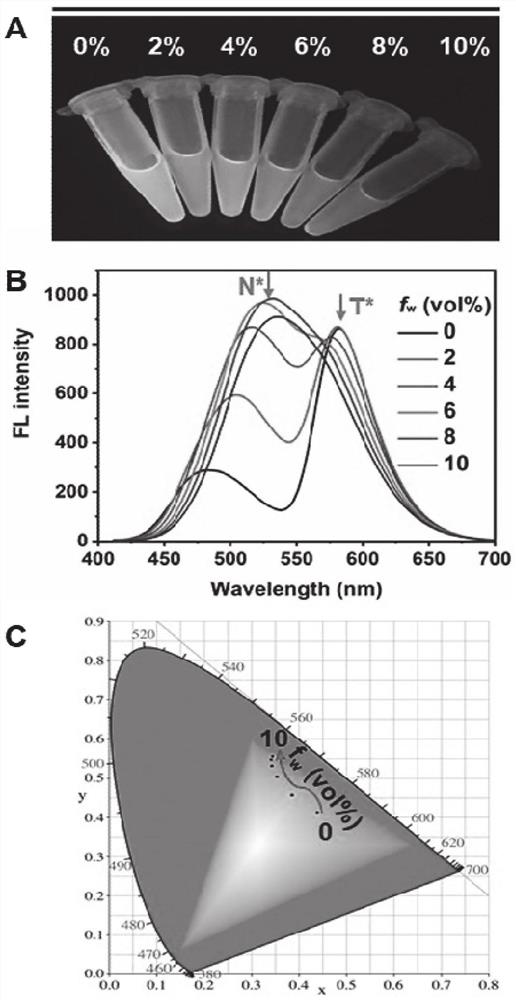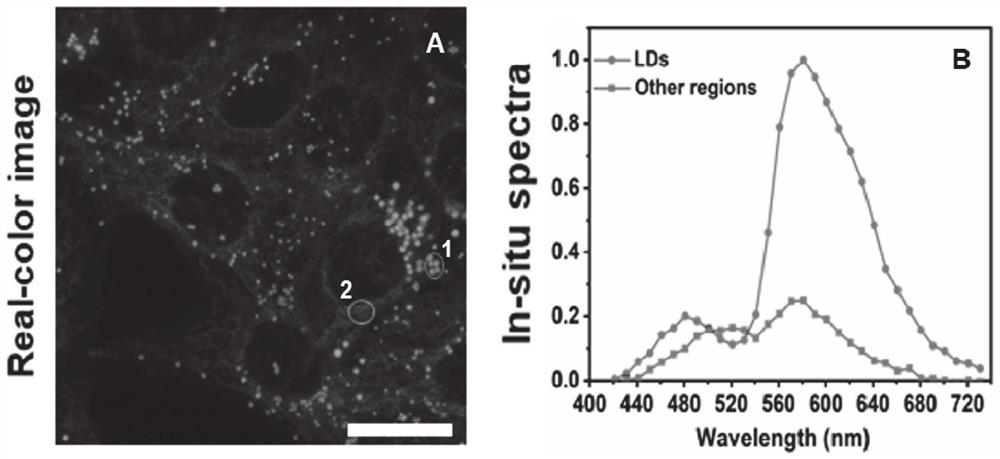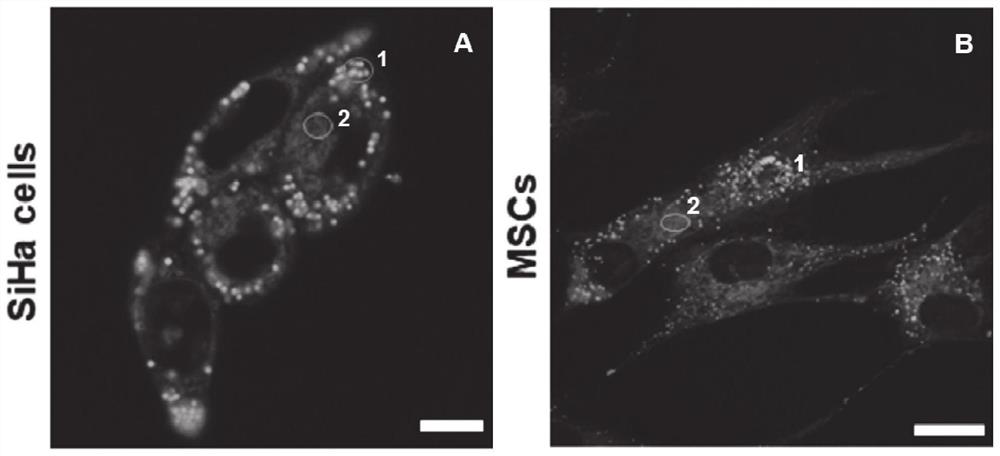Monomolecular fluorescent probe capable of simultaneously distinguishing and imaging lipid droplets and endoplasmic reticulum and application thereof
A fluorescent probe and endoplasmic reticulum technology, applied in the field of fluorescent probes
- Summary
- Abstract
- Description
- Claims
- Application Information
AI Technical Summary
Problems solved by technology
Method used
Image
Examples
Embodiment 1
[0031] Embodiment 1: the synthesis of probe PPC
[0032] A mixture consisting of 2'-hydroxyacetophenone (1 mL, 8.3 mmol) and 4-(N,N-diphenylamino)benzaldehyde (8.3 mmol) was added to the flask with ethanol (15 mL) as solvent. Then NaOH (66.4 mmol) dissolved in 2 mL of water was added to the flask and stirred at room temperature for 24 hours. Then NaOH (16.6 mmol), 2 mL of water and 3 mL of 30% H were added again to the mixture 2 o 2 , stirred at room temperature for 15 minutes, and then heated to 50° C. for 5 hours. After cooling to room temperature, the reaction system was neutralized to neutrality, then extracted with dichloromethane and washed with water three times. The residue was recrystallized to obtain a yellow powder product, namely 2-(4-(diphenylamino)phenyl)-3-hydroxy-4H-chromen-4-one, referred to as PPC. The yield was 85%.
[0033] 1 H NMR (400MHz, DMSO-d 6 ): δ(ppm)9.44(s,1H),8.16-8.06(m,3H),7.82-7.76(m,1H),7.71(dd,J=8.4,1.2Hz,1H),7.49-7.43(m ,1H),7.42-7.3...
Embodiment 2
[0034] Example 2: Sensitivity test of probe PPC to changes in water content
[0035] Prepare 2 μM PPC solution with 1,4-dioxane-water mixed solvent containing different volumes of water (0%, 2%, 4%, 6%, 8%, 10%), and then use ultraviolet light under 365nm excitation Naked-eye photographs obtained by light irradiation ( figure 1 A figure); The fluorescence emission spectrum ( figure 1 Figure B), and get the corresponding CIE1931 coordinates ( figure 1 Figure C).
[0036] Depend on figure 1 The results show that: as can be seen from the naked eye photos, PPC contains different volumes of water (0%, 2%, 4%, 6%, 8%, 10%) in 1,4-dioxane-water mixed solvents Fluorescence of different colors was produced. With the increase of water content, the fluorescence intensity of T* state remained almost unchanged, but the fluorescence intensity of N* state was significantly enhanced, and the fluorescence color also changed from orange-yellow to yellow-green. The corresponding CIE1931 co...
Embodiment 3
[0037] Embodiment 3: Preparation of live cell samples for testing
[0038] HeLa cells and SiHa cells were cultured in high glucose medium (H-DMEM) containing 10% fetal bovine serum (FBS) and 1% penicillin and streptomycin. Mesenchymal stem cells (MSCs) were cultured in H-DMEM containing 10% FBS and 1% penicillin and streptomycin. At 37°C, 5% CO 2 Passage once every 2-3 days in an incubator with saturated humidity.
[0039] When the cells grow to the logarithmic phase, culture the slices: ① Soak the coverslips in absolute ethanol for 30 minutes, dry them with an alcohol lamp and place them in a disposable 35mm culture dish for later use; Wash the cells three times with PBS, digest with 1mL 0.25% trypsin for 3-5 minutes, pour out the trypsin carefully, add fresh culture medium and pipette evenly, and count the cells. The concentration is 1×10 per ml 5 , and then inoculated into the above-mentioned petri dish containing the coverslip in 5% CO 2 Cultivate in an incubator at 3...
PUM
 Login to View More
Login to View More Abstract
Description
Claims
Application Information
 Login to View More
Login to View More - R&D Engineer
- R&D Manager
- IP Professional
- Industry Leading Data Capabilities
- Powerful AI technology
- Patent DNA Extraction
Browse by: Latest US Patents, China's latest patents, Technical Efficacy Thesaurus, Application Domain, Technology Topic, Popular Technical Reports.
© 2024 PatSnap. All rights reserved.Legal|Privacy policy|Modern Slavery Act Transparency Statement|Sitemap|About US| Contact US: help@patsnap.com










